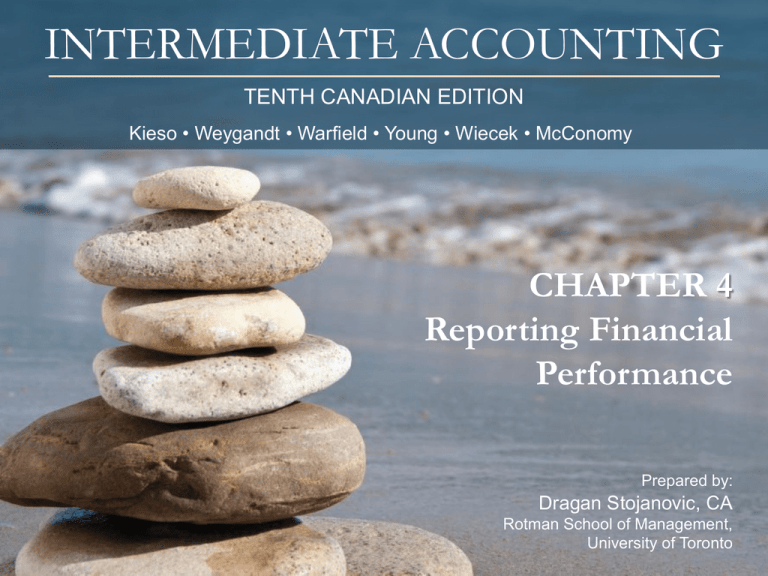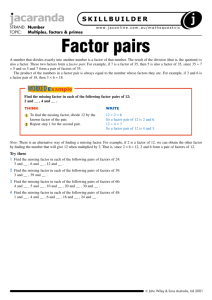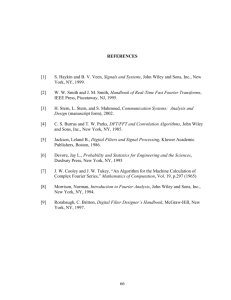
INTERMEDIATE ACCOUNTING
TENTH CANADIAN EDITION
Kieso • Weygandt • Warfield • Young • Wiecek • McConomy
CHAPTER 4
Reporting Financial
Performance
Prepared by:
Dragan Stojanovic, CA
Rotman School of Management,
University of Toronto
CHAPTER 4
Reporting Financial Performance
After studying this chapter, you should be able to:
• Understand how firms create value and manage performance.
• Understand how users use information about performance to make decisions.
• Understand the concept of and be able to assess quality of earnings/information.
• Understand the differing perspectives on how to measure income.
• Measure and report results of discontinued operations.
• Measure income and prepare the income statement and the statement of
comprehensive income using various formats.
• Prepare the statement of retained earnings and the statement of changes in
equity.
• Understand how disclosures and analysis help users of financial statements
assess performance.
• Identify differences in accounting between IFRS and ASPE and potential
changes.
2
Copyright © John Wiley & Sons Canada, Ltd.
Reporting Financial Performance
Performance
•Business models
and industries
•Communicating
information about
performance
•Quality of earnings /
information
Statement of
Income /
Comprehensive
Income
•Measurement
•Discontinued
Operations
•Presentation
Statement of
Retained Earnings /
Changes in Equity
•Presentation of
statement of retained
earnings
•Presentation of
statement of changes
in equity
Disclosure and
Analysis
•Disclosures
•Analysis
Copyright © John Wiley & Sons Canada, Ltd.
IFRS/ASPE
Comparison
•A comparison of
IFRS and ASPE
•Looking ahead
3
Business Models
• Business Model identifies three activities:
1. Financing
• Obtaining cash funding
2. Investing
• Use of funding to buy assets and invest in people
3. Operating
• Use of assets and people to generate profits
• Financial statements should capture these
fundamental business activities
Copyright © John Wiley & Sons Canada, Ltd.
4
Overview of the Business Model
Copyright © John Wiley & Sons Canada, Ltd.
5
Communicating Information About
Performance
Income Statement helps users:
1. Evaluate past performance and profitability
2. Assist in predicting future performance
3. Assess potential risk or uncertainty in achieving
future net cash inflows
Copyright © John Wiley & Sons Canada, Ltd.
6
Limitations of Income Statement
Statement of income/comprehensive income has
the following limitations:
• Items are excluded if they cannot be measured
reliably
• Amounts reported are affected by accounting
methods used
• Use of estimates in measuring income
• Financial reporting bias
• GAAP shortcomings
Copyright © John Wiley & Sons Canada, Ltd.
7
Quality of Earnings
•
•
Quality of earnings refers to how solid earnings
numbers are
Two main aspects to consider:
1. Content
•
•
Integrity of information
Sustainability of earnings
2. Presentation
•
•
Earnings presentation is clear and concise
Easy to use and understandable
Copyright © John Wiley & Sons Canada, Ltd.
8
Quality of Earnings
• Characteristics of high quality earnings:
1.
Nature of Content
–
–
–
–
–
2.
Unbiased and determined objectively
Represents economic reality
Reflects earnings from on-going core activities
Can be correlated with cash flows from operations
Based on sound business strategy/model
Presentation
–
–
–
Does not disguise or mislead (transparent)
Understandable
Also, information is clear and concise
• Earnings management decreases quality of earnings
Copyright © John Wiley & Sons Canada, Ltd.
9
Comprehensive vs. Net Income
• Key question: how do we measure income?
• IFRS generally supports the all-inclusive approach to
measuring income
– This results in “comprehensive income”
– Comprehensive income includes any non-shareholder
transactions that causes a change in equity
• Example: unrealized gains/losses on revaluation of property, plant,
and equipment under the revaluation model
– Comprehensive Income = Net Income +/- Other Comprehensive
Income (OCI)
– OCI is closed to a balance sheet account called Accumulated
Other Comprehensive Income (AOCI)
• ASPE continues to focus on net income as the measure of
income
Copyright © John Wiley & Sons Canada, Ltd.
10
Discontinued Operations
•
•
Discontinued operations includes components
that have been disposed of or are held for sale
Components can include:
-
-
-
Under ASPE: an operating segment, reporting unit,
subsidiary, asset group, or operations without
assets
Under IFRS: separate major line of business or
geographical area of operations, or a business
qualifying as “held for sale” upon acquisition
IFRS is more restrictive
Copyright © John Wiley & Sons Canada, Ltd.
11
Discontinued Operations
• A distinction made between:
- The component’s results of operations
- Disposal of the component’s assets
• The key is that the component generates
its own cash flows and has its own distinct
operations
Copyright © John Wiley & Sons Canada, Ltd.
12
Discontinued OperationsAsset Held for Sale
• Component is held for sale if the following
criteria are met:
– Authorized plan to sell exists
– Asset available for immediate sale
– Active search for a buyer
– Sale is probable within a year
– Asset is reasonably priced and marketed
– Unlikely that plan to sell will change
Copyright © John Wiley & Sons Canada, Ltd.
13
Discontinued Operations
Measurement & Presentation
• Depreciation is not recognized for held for sale
assets
• Remeasured at lower of carrying value and fair
value net of cost to sell
• Once asset is written down, subsequent gains can
be recognized only up to the amount of original loss
• Presented separately on balance sheet
– Under ASPE, held for sale asset retains original
classification as current or non-current
– Under IFRS, held for sale assets generally classified
as current
Copyright © John Wiley & Sons Canada, Ltd.
14
Discontinued Operations– Statement
Presentation
Income from continuing operations (net of tax)
$xx,xxx
Discontinued Operations:
Income (Loss) from operations (net of tax) $xx,xxx
Gain (Loss) on disposal (net of tax)
xx,xxx xx,xxx
Net Income
$xx,xxx
Earnings per share from continuing operations
$
Earnings per share from discontinued operations
Earnings per share on net income
Copyright © John Wiley & Sons Canada, Ltd.
x
x
$
x
15
Presentation of Performance
• Under IFRS, the statement of comprehensive
income can be presented either:
• as a single combined statement, or
• as two separate statements
• Companies can present income using either
– Single-step income statement, or
– Multiple-step income statement
Copyright © John Wiley & Sons Canada, Ltd.
16
Comprehensive Income Statement
• Example of a combined income and comprehensive
income statement:
•
•
•
•
•
•
Sales
Cost of goods sold
Gross profit
Operating expenses
Net income
Other comprehensive income
– Unrealized holding gain, net of tax
• Comprehensive income
Copyright © John Wiley & Sons Canada, Ltd.
800,000
600,000
200,000
90,000
110,000
30,000
140,000
17
Single-Step Income Statement
•
Presents only two groupings before Income before
Discontinued Operations:
1.
2.
•
•
Income tax expense often reported separate from
expenses as the last line item in determining net
income
Advantages:
–
–
•
Revenues (includes gains)
Expenses (includes losses)
Simplicity
Eliminates classification problems for revenues and expenses
Disadvantage:
–
–
Oversimplification
Less detail (e.g. operating and non-operating activities
reported together and cannot be distinguished)
Copyright © John Wiley & Sons Canada, Ltd.
18
Single-Step Income Statement
Revenues
–
Expenses
=
Net Income
Earnings per
Share
Revenues
Net Sales
Other Revenues
(e.g. Dividend, Rental)
Expenses
Cost of Goods Sold
Selling Expenses
Administrative Expenses
Interest Expense
Income Tax Expense
Any Gains/Losses from
Discontinued Operations must be
disclosed separately from
Continuing Operations
Copyright © John Wiley & Sons Canada, Ltd.
19
19
Multiple-Step Income Statement
• Operating and non-operating activities are
separated
• Advantages:
• Highlighting regular and irregular activities allows for
greater predictive value (assess future earnings) and
feedback value (assess past earnings)
• Provides better detail to compare companies
• Allows for ratio analysis used to assess performance
Copyright © John Wiley & Sons Canada, Ltd.
20
Multiple-Step Income Statement
Continuing Operations
•Operating section
•Nonoperating section
•Income tax
Discontinued Operations •Income/Loss from operations
•Gain/Loss from disposition
•Both reported net of taxes
Other Comprehensive Income
•Includes other
gains/losses not
included in net income
Copyright © John Wiley & Sons Canada, Ltd.
21
Continuing Operations–Detail
Operating Section
•Net Sales
•Cost of Goods Sold
•Selling Expenses
•Administrative or General Expenses
Nonoperating Section
Income Tax
•Other Revenues and Gains
•Other Expenses and Losses
•Separate income tax section on
Income from Continuing
Operations only
Copyright © John Wiley & Sons Canada, Ltd.
22
Condensed Income Statement
• Expenses are reported on the income
statement in group totals
• Details of the expense groups are included
on supplementary schedules
• Provides the advantage of a concise,
understandable income statement
• An example of trade-off between
understandability and full disclosure
• Reduces “information overload”
Copyright © John Wiley & Sons Canada, Ltd.
23
Presenting Expenses: Nature versus
Function
• Under IFRS, analysis of expenses must be
presented based on either:
– Nature of expenses (e.g. purchase of materials,
transportation costs, employee benefits, depreciation,
etc.)
– Function of expenses (e.g. cost of sales,
administrative costs, etc.)
• Choice should result in information that is more
reliable and relevant
• No similar guidance under ASPE
Copyright © John Wiley & Sons Canada, Ltd.
24
Intraperiod Tax Allocation
• Refers to the allocation of income taxes within a
fiscal period
• Certain irregular items on the income statement are
reported net of tax
• Specifically, income tax expense (or benefit) is
calculated and presented separately for the
following:
1. Income from continuing operations
2. Discontinued operations
3. Other comprehensive income
Copyright © John Wiley & Sons Canada, Ltd.
25
Earnings per Share
• Earnings per share (EPS) is considered one of the
most significant business indicators
• Indicates dollars earned per common share; it does
not report the dollars paid (or to be paid) per
common share
• EPS based on earnings before discontinued
operations and EPS based on net income must be
shown on the face of the income statement
• EPS based on discontinued operations may be
disclosed in the notes to the financial statements
Copyright © John Wiley & Sons Canada, Ltd.
26
Earnings Per Share
• Calculated as:
Net Income less Preferred Dividends
Weighted Average of Common Shares Outstanding
•
Earnings per share is subject to dilution
(reduction) if issue of additional shares is
possible in the future
•
For such situations, both Basic EPS and
Diluted EPS are presented
Copyright © John Wiley & Sons Canada, Ltd.
27
Retained Earnings Statement
• Retained earnings increases by net income and
decreases by net loss and declared dividends (both
cash and share dividends) for the year
• Correction of errors in prior periods and effects to
prior periods from accounting policy changes are
treated as prior period adjustments
• They adjust (net of tax) beginning retained earnings;
also prior years’ financial statements are restated
• Under IFRS, a Statement of Changes in Equity is
presented in lieu of a retained earnings statement.
Copyright © John Wiley & Sons Canada, Ltd.
28
Statement of Changes in Equity
This statement is required under IFRS and
presents the following:
1. Total comprehensive income
2. For each component of equity, the effects of
retrospective application/restatement
3. Reconciliation between the carrying amount of
each component of equity at the beginning
and end of the period.
Copyright © John Wiley & Sons Canada, Ltd.
29
29
Looking Ahead
• IASB and FASB are preparing a converged standard on
“Financial Statement Presentation”
– Working principles state that financial statements should:
• Provide a cohesive financial picture of an entity
• Provide information to help users assess the liquidity of an
entity
• Separate financing activities from other activities
• Provide information about measurement of assets and
liabilities, and
• Disaggregate information and present subtotals and totals
• IASB and FASB are also working on redefining the
meaning of “component” for discontinued operations
Copyright © John Wiley & Sons Canada, Ltd.
30
COPYRIGHT
Copyright © 2013 John Wiley & Sons Canada, Ltd. All
rights reserved. Reproduction or translation of this
work beyond that permitted by Access Copyright (The
Canadian Copyright Licensing Agency) is unlawful.
Requests for further information should be addressed
to the Permissions Department, John Wiley & Sons
Canada, Ltd. The purchaser may make back-up copies
for his or her own use only and not for distribution or
resale. The author and the publisher assume no
responsibility for errors, omissions, or damages caused
by the use of these programs or from the use of the
information contained herein.
Copyright © John Wiley & Sons Canada, Ltd.
31



